Cherries in brandy
This is a simple way to preserve cherries while they’re in season and enjoy them throughout the rest of the year. Follow the steps, label your jars with the month and year, and put them away in a dark place like a cupboard. Forget about them for a few months — say until Christmas — and then remember what a treat you have waiting to be opened.
In France, it is easy to find eau de vie pour fruits, a flavorless distillation that clocks in at 38 percent alcohol content. If this is not available where you live, I’d suggest using a bland vodka — or any brandy, cognac, armagnac or grappa.
As for the cherries, go for a not-too-sweet variety. The Rainier cherries pictured above work well, as do red bing cherries and morello sour cherries.
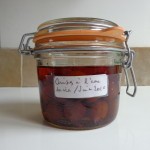 You will also need jars that can be hermetically sealed, preferably with a rubber ring, as shown in the photo. The recipe is for 2 one-pint jars.
You will also need jars that can be hermetically sealed, preferably with a rubber ring, as shown in the photo. The recipe is for 2 one-pint jars.
1 pound fresh cherries
1-3/4 cup (400 ml) eau de vie, vodka or brandy
4 tbsp. white sugar
Make sure your jars are clean and dry. If you rinse the cherries, allow them to dry before beginning.
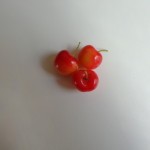 Snip off the ends of the cherry stems, leaving about 1/2 inch (1.5 cm) of stem. The stems add a delightful nutty flavor to the finished product.
Snip off the ends of the cherry stems, leaving about 1/2 inch (1.5 cm) of stem. The stems add a delightful nutty flavor to the finished product.
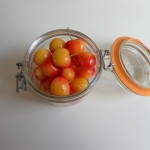 Pack the cherries into the jars, leaving a little space at the top. Fill the jars with the alcohol. Add 2 tbsp. sugar to each jar.
Pack the cherries into the jars, leaving a little space at the top. Fill the jars with the alcohol. Add 2 tbsp. sugar to each jar.
Seal the jars and give them a shake. It will take about 24 hours for the sugar to dissolve completely. To help this process along, shake the jars from time to time, turning them upside down and back again. When the sugar has completely dissolved, label your jars and put them away for at least three months.
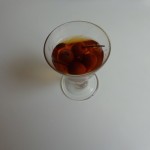 Serve the cherries on their own in pretty glasses, or over vanilla ice cream for a special dessert. Serves many, and also makes a wonderful gift.
Serve the cherries on their own in pretty glasses, or over vanilla ice cream for a special dessert. Serves many, and also makes a wonderful gift.
* Chosen by FrenchEntrée.com to celebrate 100 issues of FrenchEntrée magazine

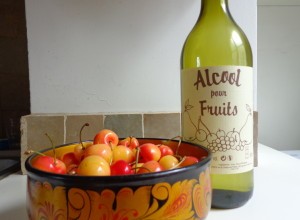




The best cherry liqueur I have ever tasted was Maraschin which was part of a fruit cocktail my wife and I had in France. I would like to have a go at making it as we have already tried Pruneaux d’Agen in Armagnac and sloe gin (with varying success).
To this end I bought some eau de vie pour fruits for the project on our last trip to Carrefour :-). I want to make a bitter cherry liqueur rather than the richer kirsch type and understand that marasca cherries are the proper choice for that.
However, I am concerned about the amygdalin in the pits turning into cyanide in the process. The recipes above seem to involve the pitted fruits, but I think Maraschino liqueur comes from the pits only and not the fruit. I ‘think’ the pits are crushed. But, if they are crushed that will surely multiply the chances of producing hydrogen cyanide? Or are they used whole?
Any advice welcome. Thanks, Jeff.
Hi Jeff. The recipe above is for whole cherries — not pitted! If that’s not clear I should amend the text. The cherries (any variety, but in my opinion less sweet = better) will remain more firm and hold their shape better if left whole.
And no, you will not get cyanide poisoning from the pits, as long as you don’t eat them! Another reader wrote in with the same good question some years back and here’s what I told her:
“Your question piqued my curiosity, so I looked into the matter and was surprised to find that cherry pits, and other fruit pits, contain a chemical that gets converted to cyanide if ingested. But the chemical will not be released if the pit remains intact. Even if you swallow a pit accidentally, it will not harm you.
“Science aside, I have been making cherries (and plums) in brandy for decades and have suffered no ill effects, except for the occasional hangover if too much brandy is consumed!”
Just fyi, marasca cherries may be hard to find in France. A common variety I’ve often used with success is the griotte. Good luck with the recipe. This is the perfect time of year!
I was intrigued by a book that discussed traditional techniques of preserving food without freezing or canning, and in that book were instructions for what it termed “sun-cooked cherries in brandy”. So two months ago, I filled quart jars with 1/2 cup of sucanat sugar and initially only 1/2 cup of brandy, but that did not cover the cherries all the way, so I decided to fill the remainder of the jar with brandy. Instead of placing the cherries in the sun, they have been on a shelf in my garage where the temps were often in the 90s. Within a week the screw topped lids were domed up. I have previously made fermented sauerkraut and thought perhaps they were fermenting and needed air released so they would not explode. So in the first initial month, perhaps once a week I slightly unscrewed the lids to release the pressure. Now I have since searched to see if this is a normal occurrence or if it is more indicative of spoilage…don’t know if you can get botulism from a non canned food source. As you have indicated that you have a lot of experience with this type of preserving, is the off gassing to be expected? I have not found any mention of this by anyone posting brandied cherry recipes. I am wondering if the cherries are safe to try. Thanks for sharing your experience.
Hi Jayne. I don’t know much about botulism but if I were you I would throw those cherries away immediately! I’ve been making cherries in brandy for many years, and never have I seen the lid of a jar dome up, or found gas inside the jars. One thing that’s important is to store the cherries in a cool dark place — I think the fact that your jars were stored in a hot garage might have caused the problem. I know it’s a drag to throw away a whole batch of beautiful cherries, but better to be safe than sorry. If you feel up to trying again next cherry season, why not give this recipe a try? It’s never failed for me. All best, Meg
Thank you so much for sharing your experience in this matter. I really appreciate it. I will save your recipe and give it a go.
Do you need to put a cut into the cherries before you soak them? I have some cherries and am going to soak them in some kind of alcohol. Thank you Shirley
Hi Shirley. No, you don’t have to cut into the cherries before soaking them — in fact, it’s best if you leave them intact with the pit inside and a bit of stem attached. That will give you the best flavor. What you could do if you like is to prick each cherry with a toothpick to help it absorb more of the alcohol. But I’ve never found this necessary with cherries — after aging for a couple of months, they’re plenty alcoholic!
Hi there- I have stored my pitted sour cherries in basically the same good recipe as yours nine months ago. They are well and truly drunk in good brandy and taste delicious.
However, having been a little uncertain at the time of preserving them as to the best type of jar to use I opted for new high quality Screw top preserving lids which have expanded over time resulting in a little oozing of the liquor. The storage is a thermally controlled wine cellar at 14c.
Unfortunately I have only just found your website and see that you chose clamped down styled jars. Is there a reason for using this type of jar over my choice? Did you fill leaving a good amount of space so it can breath? Any advice on your way of properly sealing? I have made 16 litres of them in 1 litre jars and want to decant them into smaller jars so would appreciate your views on method of preserving them and jar choice before doing so.Happy to purchase your jar choice if this is the answer. Kind regards
Hi Carol. Well the good news is that, unlike jam, cherries or other fruits preserved in brandy do not require hermetic sealing. So you can open your large jars and transfer your cherries into clean smaller jars with no problem.
I use the jars with the rubber rings because they are airtight, which simplifies the process of turning the jars over in the early stages. Other jars tend to leak. But once that process is over, a jar with a screw-top is fine. It’s best to avoid any lids that could rust, though. I leave about 1/4 to 1/2 inch of air at the top.
Your cherries will last for several years, and I’m glad they’re delicious. If you decide to make a new batch in future, I’d suggest that you not pit the cherries, as the pits impart a delightful almondy flavor to both the fruit and the brandy. Cheers, Meg
I have heard that cherry stones are poisonous. I have some brandied cherries with the stones in that are 3 years old, will it still be ok to eat and drink the brandy?
Hi Mary. Yes, it is absolutely safe to eat the cherries and drink the brandy, provided you do not actually crush or chew the cherry pits, but instead eat the fruity part and throw the pit away.
Your question piqued my curiosity, so I looked into the matter and was surprised to find that cherry pits, and other fruit pits, contain a chemical that gets converted to cyanide if ingested. But the chemical will not be released if the pit remains intact. Even if you swallow a pit accidentally, it will not harm you.
Science aside, I have been making cherries (and plums) in brandy for decades and have suffered no ill effects, except for the occasional hangover if too much brandy is consumed! Cheers, Meg
I just attempted something like this and need advice. I used dark sweet cherries, washed and pitted them, put them in a jar, covered with Kirschwasser, and stored in the refrigerator.
These cherries are for a black forest cake, for a birthday that is 4 weeks away. I was hoping this method would preserve the cherries since they probably won’t be in season by the time I make the cake. (Normally this cake recipe calls to soak the cherries in kirschwasser overnight.) The cherries will be halved and then used in the filling of the cake. I have a lot of questions:
1. Since I pitted the cherries, will they just turn to mush by the time I use them? A bit soft is OK since this is for a cake filling, but I don’t want alcoholic mush either.
2. There was a bit of air in the top of the jar – is this a problem? All of the cherries are pretty much covered in the kirschwasser.
I’m hoping I don’t have to start this process over. Any advice would be appreciated.
Hi Rebecca. Well, this is a rather unorthodox approach to the recipe, but I’m sure it will be fine for your cake. As a general rule, it’s better not to pit the cherries for two reasons — first, they hold their shape better, and second, the pits impart a delightful almond flavor to the alcohol. But in the event, I’m sure they won’t turn to mush, so not to worry. The space at the top of the jar is not a problem, in fact it’s a good thing. But did you add any sugar? If not, please open the jar and do that now. And take the jar out of the fridge! The cherries should mature at room temperature, and the sugar will help the maturation process. Good luck, and please tell us how this turns out. All best, Meg
Thank you, Meg! I put them in the fridge because I live in southern California and don’t have air conditioner – sometimes it’s a bit warm in the kitchen. Do you think this is a problem?
I appreciate the fast reply!
The best solution is to put them in a dark place for a month, say a cupboard or closet. If you’ve added sugar, you need to shake the jar from time to time until the sugar dissolves. But the heat shouldn’t be a problem, as the alcohol will protect the fruit. For example, you probably wouldn’t put a bottle of bourbon in the fridge. It’s the same principle.
The Kentucky version is made with bourbon – Cherry Bounce – delicious!
Sounds fab. If I can get hold of some bourbon over here, I’ll try it!
I have a bottle, Meg.
In fact I had 4. I could pick up one in Sept when I am in the states.
Great idea. Thanks, Carrie!